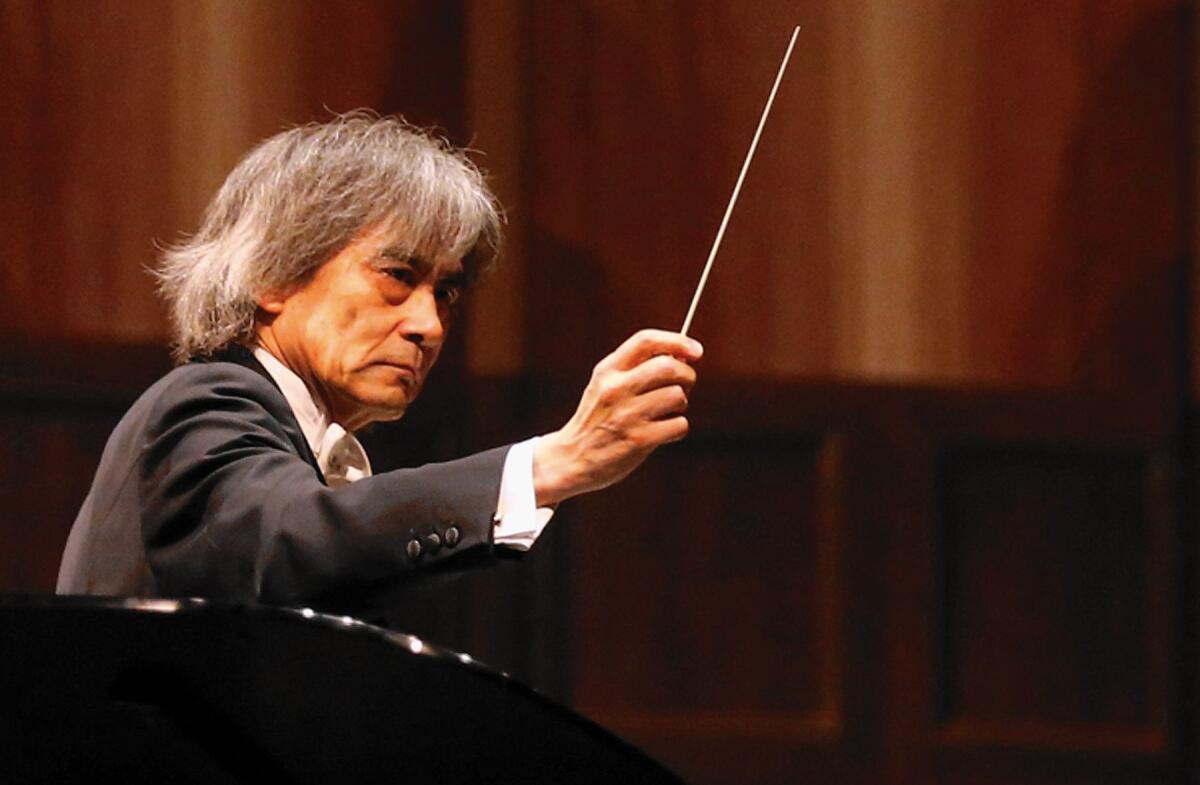Review: Kent Nagano and Orchestre Symphonique de Montréal prove gripping in Santa Barbara

- Share via
SANTA BARBARA — If you check out the surprisingly cursory Wikipedia entry on the Orchestre Symphonique de Montréal you will discovery that “in recent years, the OSM has fallen on tough times.”
That depends on how you define “recent” and maybe even “tough.” If we are talking about the early 2000s, things weren’t looking so hot. If we are talking about the triumphant concert the orchestra gave at Granada Theatre here Thursday night, there was all manner of heat — instrumental glow, sustaining emotional warmth and, when wanted, scorching fire — a rare and marvelous combination and something that can be produced only by an orchestra in glowing health.
All orchestras go through their crises, and OSM’s was certainly nasty. After having transformed what had been a relatively provincial orchestra into one that made celebrated recordings, particularly of 19th and 20th century French repertory, Charles Dutoit angrily resigned in 2002 after public complaints from players that he was abusive in rehearsals. At first the noted Swiss conductor and the orchestra came out of the contretemps worse for wear; Dutoit’s reputation was temporarily tarnished, and the orchestra suffered musically and went on strike in 2005.
The Canadians turned to then-Los Angeles Opera Music Director Kent Nagano, who left his Music Center post to simultaneously take over OSM in Montreal and the Bavarian State Opera in Munich, another politically charged challenge. Although Nagano had major successes in Munich, he survived Bavarian in-fighting only seven years and has now moved on to the Hamburg State Opera and Philharmonic. But Montreal has lasted.
The orchestra has been restored not so much to its former glory but to a new glory. That glory would be have been unthinkable without Dutoit’s quarter-century of exacting music-making in Montreal and the clear, bracing, color-drenched sound that he created. Not only has Nagano built upon that, but he has worked to diplomatically patch up relations. Last month the 79-year-old Dutoit, now hailed as an old master, returned to conduct his old band for the first time in 14 years and reportedly received a hero’s welcome.
The Granada program was, moreover, based on Dutoit specialties — Debussy’s “Prelude to the Afternoon of a Faun,” Prokofiev’s Third Piano Concerto and Stravinsky’s ballet, “The Firebird,” in its original 1910 version with an extravagantly large orchestra, including three harps. Dutoit made a Grammy-winning recording of the concerto with Martha Argerich and the OSM, and his 1984 Montreal recording of “Firebird” is a dazzler.
Nagano’s program may have relied even a little too much on Montreal tradition, given that he has opened the orchestra’s programming to much more varied and new music. Thursday night’s pieces are among each of the composer’s most popular and accessible pieces. But they also make sense together, demonstrating the creation of a new musical language that involved a remarkable interaction between France and Russia at the end of the 19th and beginning of the 20th century.
Juxtaposing Debussy’s 1894 “Faun” and Prokofiev’s 1921 concerto proved fascinating since each begins with a seductive wind solo. “Faun’s” flute opening is like being inside the flute — the burnished sound of silver. Prokofiev’s clarinet opening is the burnished sound of wood. Each is a pure, intense single flavor.
Nagano maintained the purity, but he also asked for something more, bringing out the process of making the sound as part of the sound, an intensity of breath and nuance of expression. In Japan if you eat noodles you must slurp: only by making an extraneous and even revolting noise can you properly savor the singularity of a noodle’s essence.
That kind of nuance characterized every measure of “Faun,” where an excess of sensuality extended from almost inaudible tenderness in quiet string passages to the rich, voluptuous winds.
The Prokofiev clarinet solo led to something different. The soloist was the electrifying young Russian pianist, Daniil Trifonov, who made his sensational recital debut at Walt Disney Concert Hall a month ago. In Santa Barbara, the precedent of Argerich’s OSM recording meant he had a lot to live up to, and he did.
Nagano emphasized the concerto’s modernity. While allowing for the grace and wit of the central movement’s variations, he mainly negotiated the orchestra around Trifonov, who dug with deep introspection into Prokofiev’s occasional moments of lyricism. But the pianist blew away even Argerich as he ran his fingers across the keys in fabulously glittery glissandi.
The “Firebird” was a lush feast. As in “Faun,” details stood out for their individual expressivity. An inner part seldom noticed in, say, the violas could seem like it was part of some unsuspected subplot to the fairy-tale ballet.
And that made the violence Nagano also brought out all the more arresting, especially in a gloriously nasty “Infernal Dance of Kastchei,” the ballet’s bad guy here achieving the voluptuousness of power.
Burning music-making such as this leaves a burning question. This week when Nagano and the OSM circled Southern California (performing in Palm Desert and San Diego as well as Santa Barbara), Disney Hall remained unconscionably vacant, the Los Angeles Philharmonic on tour. A date for the OSM with a stellar conductor and soloist seems not just a no-brainer but a necessity.
More to Read
The biggest entertainment stories
Get our big stories about Hollywood, film, television, music, arts, culture and more right in your inbox as soon as they publish.
You may occasionally receive promotional content from the Los Angeles Times.











